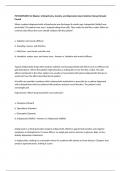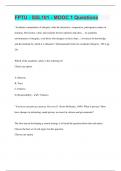PSYCHOPHARM for Bipolar, Schizophrenia, Anxiety, and Depression Exam Solution Manual Already
Passed
When a patient diagnosed with schizophrenia was discharged 6 months ago, haloperidol (Haldol) was
prescribed. The patient now says, I stopped taking those pills. They made me feel like a robot. What are
common side effects the nurse should validate with the patient?
a. Sedation and muscle stiffness
b. Sweating, nausea, and diarrhea
c. Mild fever, sore throat, and skin rash
d. Headache, watery eyes, and runny nose - Answers a. Sedation and muscle stiffness
Typical antipsychotic drugs often produce sedation and extrapyramidal side effects such as stiffness and
gait disturbance, effects the patient might describe as making him or her feel like a robot. The side
effects mentioned in the other options are usually not associated with typical antipsychotic therapy or
would not have the effect described by the patient.
A health care provider considers which antipsychotic medication to prescribe for a patient diagnosed
with schizophrenia who has auditory hallucinations and poor social function. The patient is also
overweight and
hypertensive. Which drug should the nurse advocate?
a. Clozapine (Clozaril)
b. Ziprasidone (Geodon)
c. Olanzapine (Zyprexa)
d. Aripiprazole (Abilify) - Answers d. Aripiprazole (Abilify)
Aripiprazole is a third-generation atypical antipsychotic effective against both positive and negative
symptoms of schizophrenia. It causes little or no weigh gain and no increase in glucose, high- or low-
density lipoprotein cholesterol,
or triglycerides, making it a reasonable choice for a patient with obesity or heart disease. Clozapine may
produce agranulocytosis, making it a poor
,choice as a first-line agent. Ziprasidone may prolong the QT interval, making it a poor choice for a
patient with cardiac disease. Olanzapine fosters weight gain.
A patient diagnosed with schizophrenia has taken fluphenazine (Prolixin) 5 mg po bid for 3 weeks. The
nurse now observes a shuffling propulsive gait, a mask-like face, and drooling. Which term applies to
these symptoms?
a. neuroleptic malignant syndrome
b. hepatocellular effects
c. pseudoparkinsonism
d. akathisia - Answers c. psydoparkinsonism
Pseudoparkinsonism induced by antipsychotic medication mimics the symptoms of Parkinsons disease.
It frequently appears within the first month of treatment and is more common with first-generation
antipsychotic drugs. Hepatocellular effects would produce abnormal liver test results. Neuroleptic
malignant syndrome is characterized by autonomic instability. Akathisia produces motor restlessness.
A patient diagnosed with schizophrenia is very disturbed and violent. After several doses of haloperidol
(Haldol), the patient is calm. Two hours later the nurse sees the patients head rotated to one side in a
stiff position, the lower jaw thrust forward, and drooling. Which problem is most likely?
a. Acute dystonic reaction
b. Tardive dyskinesia
c. Waxy flexibility
d .Akathisia - Answers a. Acute dystonic reaction
Acute dystonic reactions involve painful contractions of the tongue, face, neck, and back. Opisthotonos
and oculogyric crisis may be observed. Dystonic reactions are considered emergencies requiring
immediate intervention. Tardive dyskinesia involves involuntary spasmodic muscular contractions that
involve the tongue, fingers, toes, neck, trunk, or pelvis. It appears after prolonged treatment. Waxy
flexibility is a symptom seen in catatonic schizophrenia. Internal and external restlessness, pacing, and
fidgeting are characteristics of akathisia.
,An acutely violent patient diagnosed with schizophrenia receives several doses of haloperidol (Haldol).
Two hours later the nurse notices the patients head rotated to one side in a stiffly fixed position, the
lower jaw thrust forward, and drooling. Which intervention by the nurse is indicated?
a. Administer diphenhydramine (Benadryl) 50 mg IM from the PRN medication administration record.
b. Reassure the patient that the symptoms will subside. Practice relaxation exercises with the patient.
c. Give trihexyphenidyl (Artane) 5 mg orally at the next regularly scheduled medication administration
time.
d. Administer atropine sulfate 2 mg subcut from the PRN medication administration record. - Answers a.
Administer diphenhydramine (Benadryl) 50 mg IM from the PRN medication administration record.
Diphenhydramine, trihexyphenidyl, benztropine, and other anticholinergic medications may be used to
treat dystonias. Swallowing will be difficult or impossible; therefore, oral medication is not an option.
Medication should be administered immediately, so the intramuscular route is best. In this case, the
best option given is diphenhydramine.
A patient took trifluoperazine 30 mg po daily for 3 years. The clinic nurse notes that the patient grimaces
and constantly smacks both lips. The patients neck and shoulders twist in a slow, snakelike motion.
Which problem would the nurse suspect?
a. Agranulocytosis
b. Tardive dyskinesia
c. Tourettes syndrome
d. Anticholinergic effects - Answers b. Tardive dyskinesia
Tardive dyskinesia is a neuroleptic-induced condition involving the face, trunk, and limbs. Involuntary
movements, such as tongue thrusting; licking; blowing; irregular movements of the arms, neck, and
shoulders; rocking; hip jerks; and pelvic thrusts, are seen. These symptoms are frequently not reversible
even when the drug is discontinued. The scenario does not present evidence consistent with the other
disorders mentioned. Agranulocytosis is a blood disorder. Tourettes syndrome is a condition in which
tics are present. Anticholinergic effects include dry mouth, blurred vision, flushing, constipation, and dry
eyes.
, A patient diagnosed with schizophrenia begins a new prescription for lurasidone HCL (Latuda). The
patient is 56 and currently weighs 204 lbs.
Which topic is most important for the nurse to include in the teaching plan related to this medication?
a. How to recognize tardive dyskinesia
b. Weight management strategies
c. Ways to manage constipation
d. Sleep hygiene measures - Answers b. Weight management strategies
Lurasidone HCL (Latuda) is a second-generation antipsychotic medication. The incidence of weight gain,
diabetes, and high cholesterol is high with this medication. The patient is overweight now, so weight
management will be especially important. The incidence of tardive dyskinesia is low with second-
generation antipsychotic medications. Constipation may occur, but it is less important than weight
management. This drug usually produces drowsiness.
A patient diagnosed with schizophrenia has taken a conventional antipsychotic medication for a year.
Hallucinations are less intrusive, but the patient continues to have apathy, poverty of thought, and social
isolation. The nurse would expect a change to which medication?
a. Haloperidol (Haldol)
b. Olanzapine (Zyprexa)
c. Chlorpromaine (Thorazine)
d. Diphenhydramine (Benadryl) - Answers b. Olanzapine (Zyprexa)
Olanzapine is a second-generation atypical antipsychotic that targets both positive and negative
symptoms of schizophrenia. Haloperidol and chlorpromazine are conventional antipsychotics that target
only positive symptoms. Diphenhydramine is an antihistamine.
A patient receiving risperidone (Risperdal) reports severe muscle stiffness at 1030. By 1200, the patient
has difficulty swallowing and is drooling. By 1600, vital signs are 102.8 F; pulse 110; respirations 26;
150/90. The patient is diaphoretic. Select the nurses best analysis and action.





